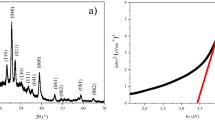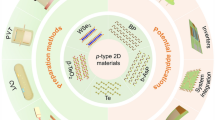Abstract
There are many studies on the solution-processed thin-film transistor (TFT) using transition metal dichalcogenide (TMD) materials. However, it is hard to control the electrical property of chemically exfoliated TMD materials compared to the chemical vapor deposition TMD. An investigation into the electrical modulation behavior of exfoliated two-dimensional (2D) material is important to fabricate well-modulated electronic devices via solution processing. Here, we report the effects of reactivity of organic dopants on MoS2 and investigate how the chemical doping behavior influences the electrical properties of MoS2. The band state of dopants, which is related to the electron-withdrawing and donating behavior of chemical dopant, provides a proportional shift in the threshold voltages (Vth) of their field-effect transistors (FETs). However, on/off current ratio (Ion/Ioff) and mobility (µ) are strongly influenced by the defect density depending on the reactivity of doping reaction, rather than the band state of organic dopants. Through the in-depth study on the doping reaction, we fabricate a FET and a TFT, having high mobility and a relatively high on/off ratio (104) using a solution process.

Similar content being viewed by others
Reference
Wang, Q. H.; Kalantar-Zadeh, K.; Kis, A.; Coleman, J. N.; Strano, M. S. Electronics and optoelectronics of two-dimensional transition metal dichalcogenides. Nat. Nanotechnol. 2012, 7 699–712.
Choi, M.; Park, Y. J.; Sharma, B. K.; Bae, S. R.; Kim, S. Y.; Ahn, J. H. Flexible active-matrix organic light-emitting diode display enabled by MoS2 thin-film transistor. Sci. Adv. 2018, 4 eaas8721.
Lyu, H. M.; Liu, X.; Rogers, N.; Gilja, V.; Kuzum, D. Graphene neural interfaces for artifact free optogenetics. In Proceedings of the 2016 38th Annual International Conference of the IEEE Engineering in Medicine and Biology Society (EMBC), Orlando, FL, USA, 2016, pp 4204–4207.
Kim, J.; Kwon, S. M.; Kang, Y. K.; Kim, Y. H.; Lee, M. J.; Han, K.; Facchetti, A.; Kim, M. G.; Park, S. K. A skin-like two-dimensionally pixelized full-color quantum dot photodetector. Sci. Adv. 2019, 5 eaax8801.
Chhowalla, M.; Jena, D.; Zhang, H. Two-dimensional semiconductors for transistors. Nat. Rev. Mater. 2016, 1 16052.
Chhowalla, M.; Shin, H. S.; Eda, G.; Li, L. J.; Loh, K. P.; Zhang, H. The chemistry of two-dimensional layered transition metal dichalcogenide nanosheets. Nat. Chem. 2013, 5 263–275.
Islam, M. R.; Kang, N.; Bhanu, U.; Paudel, H. P.; Erementchouk, M.; Tetard, L.; Leuenberger, M. N.; Khondaker, S. I. Tuning the electrical property via defect engineering of single layer MoS2 by oxygen plasma. Nanoscale 2014, 6 10033–10039.
Das, S.; Chen, H. Y.; Penumatcha, A. V.; Appenzeller, J. High performance multilayer MoS2 transistors with scandium contacts. Nano Lett. 2013, 13 100–105.
Cai, X. K.; Luo, Y. T.; Liu, B. L.; Cheng, H. M. Preparation of 2D material dispersions and their applications. Chem. Soc. Rev. 2018, 47 6224–6266.
Knirsch, K. C.; Berner, N. C.; Nerl, H. C.; Cucinotta, C. S.; Gholamvand, Z.; McEvoy, N.; Wang, Z. X.; Abramovic, I.; Vecera, P.; Halik, M. et al. Basal-plane functionalization of chemically exfoliated molybdenum disulfide by diazonium salts. ACS Nano 2015, 9 6018–6030.
Stergiou, A.; Tagmatarchis, N. Molecular functionalization of two-dimensional MoS2 nanosheets. Chem. —Eur. J. 2018, 24 18246–18257.
Menanteau, T.; Dias, M.; Levillain, E.; Downard, A. J.; Breton, T. Electrografting via diazonium chemistry: The key role of the aryl substituent in the layer growth mechanism. J. Phys. Chem. C 2016, 120 4423–4429.
Kim, S.; Konar, A.; Hwang, W. S.; Lee, J. H.; Lee, J.; Yang, J.; Jung, C.; Kim, H.; Yoo, J. B.; Choi, J. Y. et al. High-mobility and low-power thin-film transistors based on multilayer MoS2 crystals. Nat. Commun. 2012, 3 1011.
Bhojane, J. M.; Sarode, S. A.; Nagarkar, J. M. Aryl diazonium salt and thioacetamide: A catalyst free, efficient blend of an inexpensive arylating agent with “S” surrogate for sulphide synthesis. RSC Adv. 2016, 6 90046–90050.
Lee, H.; Bak, S.; An, S. J.; Kim, J. H.; Yun, E.; Kim, M.; Seo, S.; Jeong, M. S.; Lee, H. Highly efficient thin-film transistor via cross-linking of 1t edge functional 2H molybdenum disulfides. ACS Nano 2017, 11 12832–12839.
Assresahegn, B. D.; Brousse, T.; Bélanger, D. Advances on the use of diazonium chemistry for functionalization of materials used in energy storage systems. Carbon 2015, 92 362–381.
Collins, G.; Fleming, P.; O’Dwyer, C.; Morris, M. A.; Holmes, J. D. Organic functionalization of germanium nanowires using arenediazonium salts. Chem. Mater. 2011, 23 1883–1891.
Voiry, D.; Goswami, A.; Kappera, R.; de Carvalho Castro e Silva, C.; Kaplan, D.; Fujita, T.; Chen, M. W.; Asefa, T.; Chhowalla, M. Covalent functionalization of monolayered transition metal dichalcogenides by phase engineering. Nat. Chem. 2014, 7 45–49.
Choi, J. H.; Wang, H.; Oh, S. J.; Paik, T.; Sung, P.; Sung, J.; Ye, X. C.; Zhao, T. S.; Diroll, B. T.; Murray, C. B. et al. Exploiting the colloidal nanocrystal library to construct electronic devices. Science 2016, 352 205–208.
Du, Y. C.; Liu, H.; Neal, A. T.; Si, M. W.; Ye, P. D. Molecular doping of multilayer MoS2 field-effect transistors: Reduction in sheet and contact resistances. IEEE Electron Device Lett. 2013, 34 1328–1330.
Ding, Q.; Czech, K. J.; Zhao, Y. Z.; Zhai, J. Y.; Hamers, R. J.; Wright, J. C.; Jin, S. Basal-plane ligand functionalization on semiconducting 2H-MoS2 monolayers. ACS Appl. Mater. Interfaces 2017, 9 12734–12742.
Wang, H.; Bi, S. G.; Ye, Y. S.; Xue, Y.; Xie, X. L.; Mai, Y. W. An effective non-covalent grafting approach to functionalize individually dispersed reduced graphene oxide sheets with high grafting density, solubility and electrical conductivity. Nanoscale 2015, 7 3548–3557.
Haratipour, N.; Namgung, S.; Oh, S. H.; Koester, S. J. Fundamental limits on the subthreshold slope in schottky source/drain black phosphorus field-effect transistors. ACS Nano 2016, 10 3791–3800.
Greenwood, J.; Phan, T. H.; Fujita, Y.; Li, Z.; Ivasenko, O.; Vanderlinden, W.; van Gorp, H.; Frederickx, W.; Lu, G.; Tahara, K. et al. Covalent modification of graphene and graphite using diazonium chemistry: Tunable grafting and nanomanipulation. ACS Nano 2015, 9 5520–5535.
Sim, D. M.; Han, H. J.; Yim, S.; Choi, M. J.; Jeon, J.; Jung, Y. S. Long-term stable 2H-MoS2 dispersion: Critical role of solvent for simultaneous phase restoration and surface functionalization of liquid-exfoliated MoS2. ACS Omega 2017, 2 4678–4687.
Vishnoi, P.; Sampath, A.; Waghmare, U. V.; Rao, C. N. R. Covalent functionalization of nanosheets of MoS2 and MoSe2 by substituted benzenes and other organic molecules. Chem. —Eur. J. 2017, 23 886–895.
Hunger, R.; Jaegermann, W.; Merson, A.; Shapira, Y.; Pettenkofer, C.; Rappich, J. Electronic structure of methoxy-, bromo-, and nitrobenzene grafted onto Si(111). J. Phys. Chem. B 2006, 110 15432–15441.
Tan, S. J. R.; Sarkar, S.; Zhao, X. X.; Luo, X.; Luo, Y. Z.; Poh, S. M.; Abdelwahab, I.; Zhou, W.; Venkatesan, T.; Chen, W. et al. Temperature-and phase-dependent phonon renormalization in 1T′-MoS2. Acs Nano 2018, 12 5051–5058.
Benson, E. E.; Zhang, H. Y.; Schuman, S. A.; Nanayakkara, S. U.; Bronstein, N. D.; Ferrere, S.; Blackburn, J. L.; Miller, E. M. Balancing the hydrogen evolution reaction, surface energetics, and stability of metallic MoS2 nanosheets via covalent functionalization. J. Am. Chem. Soc. 2018, 140 441–450.
Li, H.; Zhang, Q.; Yap, C. C. R.; Tay, B. K.; Edwin, T. H. T.; Olivier, A.; Baillargeat, D. From bulk to monolayer MoS2: Evolution of raman scattering. Adv. Funct. Mater. 2012, 22 1385–1390.
Chakraborty, B.; Bera, A.; Muthu, D. V. S.; Bhowmick, S.; Waghmare, U. V.; Sood, A. K. Symmetry-dependent phonon renormalization in monolayer MoS2 transistor. Phys. Rev. B 2012, 85 161403.
Lin, J. D.; Han, C.; Wang, F.; Wang, R.; Xiang, D.; Qin, S. Q.; Zhang, X. A.; Wang, L.; Zhang, H.; Wee, A. T. S. et al. Electron-doping-enhanced trion formation in monolayer molybdenum disulfide functionalized with cesium carbonate. ACS Nano 2014, 8 5323–5329.
Hallam, T.; Duffy, C. M.; Minakata, T.; Ando, M.; Sirringhaus, H. A scanning Kelvin probe study of charge trapping in zone-cast pentacene thin film transistors. Nanotechnology 2008, 20 025203.
Song, I.; Park, C.; Choi, H. C. Synthesis and properties of molybdenum disulphide: From bulk to atomic layers. RSC Adv. 2015, 5 7495–7514.
Lee, H.; Bak, S.; Cho, Y.; Kim, M.; Kang, S. H.; Bui, V. Q.; Le, H. M.; Kim, S. W.; Lee, H. Hydrogen adsorption engineering by intramolecular proton transfer on 2D nanosheets. NPG Asia Mater. 2018, 10 441–454.
Cai, Y. Q.; Zhou, H. B.; Zhang, G.; Zhang, Y. W. Modulating carrier density and transport properties of MoS2 by organic molecular doping and defect engineering. Chem. Mater. 2016, 28 8611–8621.
Ouyang, B.; Mi, Z. T.; Song, J. Bandgap transition of 2H transition metal dichalcogenides: Predictive tuning via inherent interface coupling and strain. J. Phys. Chem. C 2016, 120 8927–8935.
Nguyen, E. P.; Carey, B. J.; Ou, J. Z.; van Embden, J.; Gaspera, E. D.; Chrimes, A. F.; Spencer, M. J. S.; Zhuiykov, S.; Kalantar-Zadeh, K.; Daeneke, T. Electronic tuning of 2D MoS2 through surface functionalization. Adv. Mater. 2015, 27 6225–6229.
Gao, M. R.; Liang, J. X.; Zheng, Y. R.; Xu, Y. F.; Jiang, J.; Gao, Q.; Li, J.; Yu, S. H. An efficient molybdenum disulfide/cobalt diselenide hybrid catalyst for electrochemical hydrogen generation. Nat. Commun. 2015, 6 5982.
Radisavljevic, B.; Kis, A. Mobility engineering and a metal-insulator transition in monolayer MoS2. Nat. Mater. 2013, 12 815–820.
Eda, G.; Yamaguchi, H.; Voiry, D.; Fujita, T.; Chen, M. W.; Chhowalla, M. Photoluminescence from chemically exfoliated MoS2. Nano Lett. 2011, 11 5111–5116.
Roy, K.; Mukhopadhyay, S.; Mahmoodi-Meimand, H. Leakage current mechanisms and leakage reduction techniques in deep-submicrometer CMOS circuits. Proc. IEEE 2003, 91 305–327.
Acknowledgements
This work was supported by the Institute for Basic Science (No. IBS-R011-D1).
Author information
Authors and Affiliations
Corresponding author
Electronic Supplementary Material
Rights and permissions
About this article
Cite this article
Lee, H., Bak, S., Kim, J. et al. The effect of the dopant’s reactivity for high-performance 2D MoS2 thin-film transistor. Nano Res. 14, 198–204 (2021). https://doi.org/10.1007/s12274-020-3068-2
Received:
Revised:
Accepted:
Published:
Issue Date:
DOI: https://doi.org/10.1007/s12274-020-3068-2




